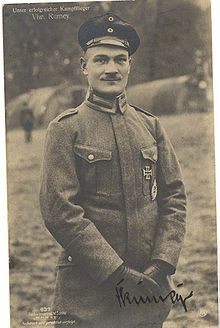Fritz Rumey
Fritz Rumey (born March 3, 1891 in Koenigsberg , † September 27, 1918 in Cambrai ) was a German fighter pilot in the First World War . With 45 confirmed aerial victories, he was the sixth most successful fighter pilot of the First World War.
Life
Rumey embarked on a military career after finishing school. At the beginning of the First World War he served in the 45th Infantry Regiment . He later belonged to the 3rd Grenadier Regiment and was transferred to the German Eastern Front.
In mid-1915 Rumey successfully applied for training as a military pilot. At first he was used as an observer. After completing his training, he was employed as a pilot in Jagdstaffel 2 in May 1917 . A short time later he was transferred to Jasta 5, where he formed the “Golden Triumvirate” together with his comrades Josef Mai and Otto Könnecke - the three pilots shot down 109 enemy aircraft by the end of the war.
Rumey became one of the most famous German fighter pilots. In total, he achieved 45 aerial victories. On July 10, 1918, he was awarded the Pour le Mérite . He suffered injuries on August 25 and September 24, 1918. The Fokker D.VII , led by Rumey, crashed in the course of an aerial battle with an Allied aircraft flown by the South African George Lawson . Rumey managed to jump off, but his parachute did not open. Rumey had a fatal accident.
After his death, a street in the Fliegerviertel in Berlin-Tempelhof was named Rumeyplan after him. In other German communities, too, such names were occasionally given in his honor.
Awards
- Prussian military pilot badge
- Iron Cross 2nd and 1st class
- Gold Military Merit Cross
- Pour le Mérite
literature
- Jürgen Brinkmann: The knights of the order Pour le merite 1914 - 1918. Th. Schäfer Druckerei GmbH Hanover, Bückeburg 1982
- Walter Zuerl: Pour le merite-Flieger. Luftfahrtverlag Axel Zuerl, 1987. ISBN 9783934596153
See also
| personal data | |
|---|---|
| SURNAME | Rumey, Fritz |
| BRIEF DESCRIPTION | German fighter pilot |
| DATE OF BIRTH | March 3, 1891 |
| PLACE OF BIRTH | Koenigsberg |
| DATE OF DEATH | September 27, 1918 |
| Place of death | Cambrai |
